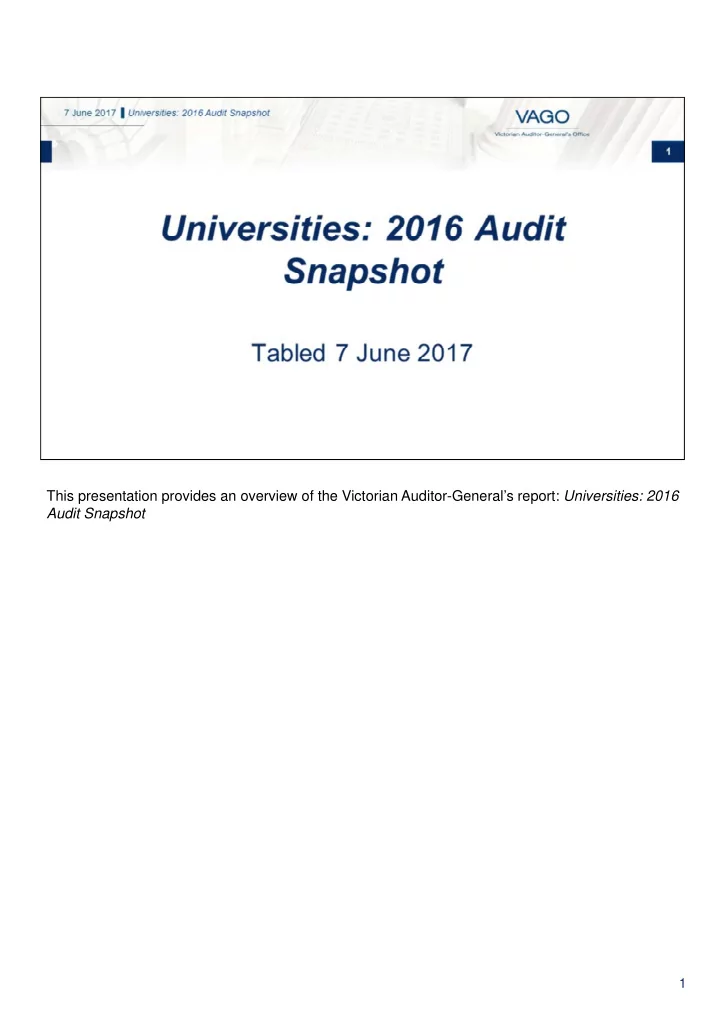

This presentation provides an overview of the Victorian Auditor-General’s report: Universities: 2016 Audit Snapshot 1
Eight universities and their 51 controlled entities make up the public university sector in Victoria. Collectively, they make a significant contribution to the state and national economy through their principal activities of higher education and research. Their main sources of revenue—student fees and student grants—and their operations are driven primarily by the number of enrolments. 2
In this report we looked at matters noted during our audits, the financial sustainability of the sector, and we conducted a deeper review of the controls in place for fraud management at universities. We have concluded that universities’ financial sustainability, reporting and internal controls are generally sound. 3
We issued audit opinions to 55 of the 59 university sector entities on their financial reports for the year ended 31 December 2016. We are yet to complete our audits of the remaining four entities at the date of this report. We qualified the 2016 financial reports of Deakin University, the University of Melbourne and the Australian National Academy of Music. All three qualifications stem from the same issue around recognising grant revenue. In our opinion, the accounting for government grants adopted by these three entities does not comply with Australian Accounting Standards. Revenue recognition is a long-standing issue in the sector. New accounting standards, which adopt a different approach to revenue recognition and measurement, will be introduced in 2019. Therefore, this is an opportune time for the sector to review and realign their revenue accounting policies, as they will need to do a significant amount of work to be able to comply with these new standards. We have made a recommendation in this report that universities commence that work. 4
As shown in the graph on this slide, the sector continues to grow. Assets in the sector totalled $20.8 billion at 31 December 2016 compared with liabilities of $4.8 billion. The universities have large cash and investment holdings and relatively low debt. At the same time, universities have taken on more debt to fund capital investment. The universities’ strong financial performance is underpinned by year-on-year growth in student enrolments, which has led to revenue growth. However, the net result margin at the sector level is declining. This indicates that universities could do more to identify opportunities to improve their cost-effectiveness and efficiency. 5
The sector is investing in capital development and spent over $1 billion in 2016. This investment is occurring in longer-term assets, such as student accommodation. At the sector level, the results for our capital replacement indicator do not flag a risk. However, there are some individual results that flag concern. In particular, at three universities the expenditure on renewing and maintaining their physical assets in 2015 and 2016 was lower than the assets’ decline in value through use. This may mean that assets at these universities will deteriorate over time and will no longer be fit for purpose. This emerging risk should be on the radar of these universities. 6
This year we reviewed the fraud control frameworks in place at universities. We did this by assessing the university frameworks against the Australian Standard and better practice information published by the Independent Broad-based Anti-corruption Commission. Most universities have sound policies and procedures in place to manage their fraud risks. However, we did note areas for improvement. 7
We made three recommendations for universities to: • to prepare for the new accounting standards for revenue • to strengthen their fraud risk management • and to review their long-term plans for asset renewal and replacement to satisfy themselves that they will be able to be maintained and replaced when needed. 8
For further information, please see the full report of this audit on our website, www.audit.vic.gov.au. 9
Recommend
More recommend